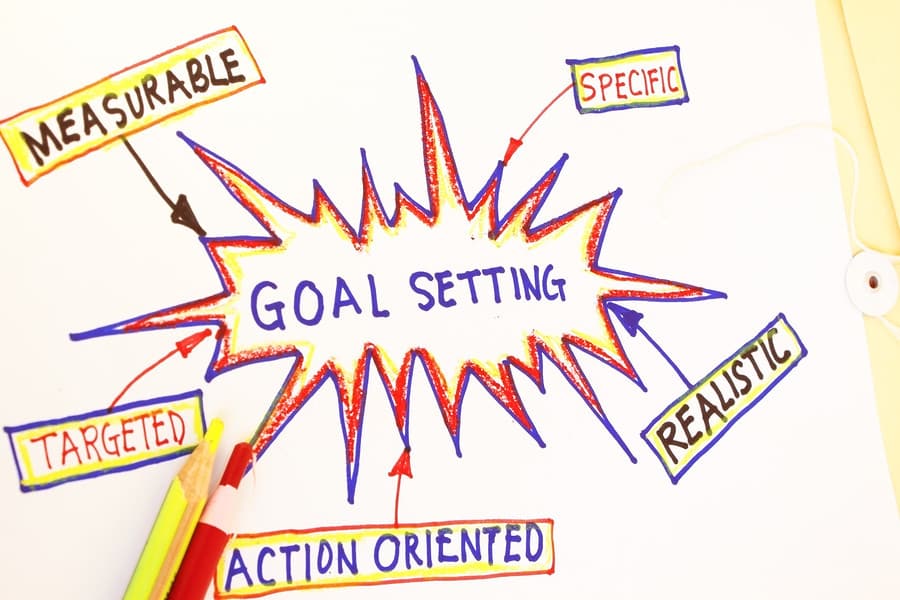
Setting goals is one thing and setting effective goals is another. Remember, that a goal without a plan is just a wish! And hence, goal setting is the first step towards achieving dreams that come to fruition and don’t just stay in one’s imagination. With children, setting effective goals is even more important since their life’s foundation and future course depend on the habits and behaviors developed during adolescence.
Why is Setting Effective Goals Not-so-Intuitive?
Children often set goals that look ambitious and enthralling in the first place. These goals can be academic or personal or both sometimes, for example, getting better grades than last year, engaging in more physical activity, getting selected in one committee, etc.

The motivation to achieve these goals fizzles out rather quickly as days pass by and, the result? Nothing (or sometimes worse than before). This sounds familiar, isn’t it? Most parents have witnessed their children not live up to their resolutions and achieve goals they set for themselves. Now take a moment to assess what was wrong with all the above examples? Why do children fail to achieve goals that they themselves set out ambitiously at the beginning of the academic year?
This happens because of just one reason – the goals set are NOT effective goals at all! Here are 3 mistakes that can make goals highly ineffective and deter a child from hustling for their life goals:
- Setting vague, small, and irrelevant goals
- Not having a plan of action and enough guidance
- Not having a trackable goal or not implementing a tracking mechanism to assess progress and figure out course-correcting steps
5 Tested Ways to Help Your Child Set Effective Goals
As a parent, you can do a lot to help your child set effective goals and achieve them. From building their confidence to helping them lay an action plan, you can play an important part in your child’s goal-setting and achievement journey.
1. Give them the freedom to choose their ‘big’ goal
Let your child choose their goal for the year or for six months. This goal has to be organic and purely of their own liking. It doesn’t have to be something like becoming a doctor. It rather be something like learning a new language, securing an A in a subject(s), learning how to play an instrument, etc. Once your child chooses their goal, they will participate in achievement planning much more actively. This way you can take them directly from being an order taker (and eventual quitter) to being a planner and an achiever. Ask them questions like they would want to pursue that very goal and what is their action plan to achieve it. Also, ask about the help they think they’ll need on the way to achieving that big goal.
2. Identify the key goal conflicts and negative blocks
Next, identify the major blocks or limiting beliefs your child may be harboring that may impede their achievement of the ‘big goal’. This is best understood with an example. So if for example, your child has chosen to learn French as the goal, you should be looking out for certain statements which can represent certain limiting beliefs or half-heartedness:
- “I should learn French because it is quite popular. All my friends are learning French and Spanish. Although, I wanted to learn Dutch.”
- “French is a tough language but I think I should learn it.”
- “I am good at math, learning languages and writing is just not my thing. But, I still will take it up as my goal this year.”
- “I want to learn French this year but there are no good French tutors or classes nearby.”
- “My school friend Sandy learned French last year for two days every week. He still doesn’t know how to say a full sentence on his own in French!”
All of these innocuous-sounding statements could imply some deep-rooted negative thoughts about learning French. Look out for such statements and replace them with positive affirmations. You could actually have a life coach work with your child to remove all possible negative thoughts and limiting beliefs your child may be harboring. We’ll talk about the wonders life coaching can do for your child in another section below.
3. Tie the goal to your child’s intrinsic motivation
Tie your child’s goal to a material gratification and watch them lose interest in no time. And, tie your child’s goal to their intrinsic motivation and watch them thrive and (over)achieve! For example, if your child loves dinosaurs, don’t tie a goal like learning level-2 French to earn a visit to a dino museum they love. You could instead help them choose a goal like learning about Paleontology and writing an essay on it in French. Follow it with a mid-course visit to their favorite dino museum to keep their motivation high.

Also, above all, don’t forget to celebrate even the smallest of wins and motivate your child to gun for bigger goals with every attempt. Be their biggest cheerleader!
4. Help your child always set S.M.A.R.T goals for themselves
Organizations across the world today lay a clear focus on having SMART goals for the teams. S.M.A.R.T. is a mnemonic acronym, giving criteria to guide in the setting of goals and objectives, for example in employee-performance management and personal development.
Let’s take a general life goal for example. An introverted child wanting to make more friends can set a goal two ways:
- “I will go out more often and make new friends this year.”
- “I will attend 9 out of the 10 birthday parties that I am invited to this year to make new friends and overcome my shyness.”
The second is an example of a S.M.A.R.T goal. A child is much more likely to achieve success with the second goal statement than the first. Evidently, the second goal statement is clear, time-bound, actionable, measurable, and hence effective.

With this premise, let’s understand S.M.A.R.T goals a little better:
- S stands for Specific. Your child’s goals should be clear and specific. For example, achieving an A in math or improving ACT score by 2 points
- M stands for Measurable. Goals that can be measured are easy to develop a plan of action for – with clear milestones.
- A stands for Achievable. Setting a goal of achieving a perfect 36 on the ACT can sound ambitious and high-octane. Setting a goal of improving the ACT score by 10 points is much more achievable and actionable.
- R stands for Relevant. Setting goals that are relevant for your child are important for many reasons. For example, the motivation to achieve relevant goals is higher and organic.
- T stand for Time-bound. Goals that have a deadline can usually be worked backward into milestones and an action plan. A goal with no timeline is often de-prioritized if not eventually dismissed.
Read more examples of S.M.A.R.T goals for children here.
5. Get your child a life coach
Life coaching can do wonders for your child. It’s not about giving them inspirational talks or real-life examples. It is about systematically unlocking their full potential so that they can achieve the goals they set for themselves. Life coaching enables children to live their dreams without inhibitions or limiting beliefs about their capabilities or opportunities available.
Why should your child work with a life coach?
Just like every athlete and entrepreneur needs one to succeed, a life coach helps your child identify their strengths, double down on them, and unlock their full potential. So that success comes as naturally as breathing.
Interested, but don’t know where to start?
At PALO, you can find your child’s perfect match for a life coach. We believe that the right kind of life coaching can make your child organized, motivated, happy and resilient – the secret sauce to being successful in life overall. We endeavor to foster life skills, academic & social-emotional skills in your child. By getting your child a life coach you can help them thrive – both at school & in life!
There are just 3 simple steps to taking your child’s learning journey to a whole new orbit:
- Sign up for the waitlist. Get a FREE 20-min consultation with a Palo Coach. No commitments. After your FREE consultation, you can choose to enroll or not. It’s on you. But we hope you’ll like us!
- Get a Smart Coach assigned to your child. We use PALO’s unique SMART pairing technique to find your child their perfect match. We pair your child with a life coach who matches their personality and interests.
- Next, come in bite-sized coaching sessions. Your child starts daily coaching sessions, 10 mins every day.
The coach will prepare a roadmap for your child after assessing their strengths and weaknesses. They will then start assigning daily activities and small challenges to your child. Try PALO and watch your child thrive in every sphere of life. Join the waitlist today!
Follow our blog for more informative articles with practical and actionable advice.
